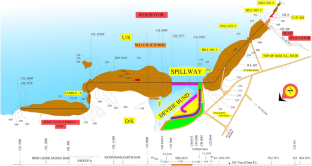Abstract
India has been known for having a large number of multipurpose dams. Some dam components are required to be designed for taking hydrodynamic loads. Divide bund or guide bund separating flows from the spillway and the hydropower turbines needs to have an armor that can take care of cyclic loads. In majority of old dams, such protective armors used to be in the form of rubble mound or pitching of suitable thickness. Their deterioration under the effect of trains of water waves required a mandatory periodic repair. Divide bund of Ukai dam of India used to require heavy repairs. It was restored using geosynthetics instead of conventional materials. As a flagship task, its design required to be founded on principles and approaches applied to some other kinds of problems. Promising results of this pilot project have prompted documenting experiences so as to encourage application of geosynthetics in designs of many parts of the dams subjected to hydrodynamic loads and hence this paper.













References
India-WRIS: Water Resources Projects sub-information system of Ministry of Jal Shakti, Government of India, www.https://indiawris.gov.in/
IS-7365 (2010) Criteria for Hydraulic Design of Bucket Type Energy Dissipators. Bureau of Indian Standards, India, pp 13–15
Naini S (2011) Evaluation of RBF, GR and FFBP neural networks for prediction of geometrical dimensions of scour hole below ski-jump spillway. In: International Conference on Environmental and Computer Science. IPCBEE vol 19 IACSIT Press, Singapore, pp 89–93
Burcharth HF, Huges SA (2003) Fundamentals of Design. Coastal Engineering Manual (vol 6). Coastal Engineering Research Center, Aalborg University, Denmark, pp VI-5-51-54
IRC-89 (2019) Guidelines of Design and Construction of River Training and Control Works for Road Bridges. Indian Road Congress, India, pp 13–15
IS-10751 (1994) Planning and Design of Guide Banks for Alluvial Rivers. Bureau of Indian Standards, India, pp 5–9
IS-14262 (1995) Planning and Design of Revetment—Guidelines. Bureau of Indian Standards, India, pp 1–2
IS-13195 (1991) Preliminary Design, Operation and Maintenance of Protection Works Downstream of Spillways—Guidelines. Bureau of Indian Standards, India, pp 3–7
Cuelho E, Perkins S, Morris Z (2014) Relative Operational Performance of Geosynthetics Used As Subgrade Stabilization. FHWA/MT-14-002/7712-251, USA, pp 1–2
Carr JH (1954) Breaking Wave Forces on Plane Barriers. Hydrodynamics Laboratory, California Institute of Technology, USA, pp 5–12
Burcharth HF (1992) Design and Reliability of Coastal Structures, short course during the 23rd ICCE in Venice. ICCE Local organizing committee http://resolver.tudelft.nl/uuid:cec953ec-9e3b-41e4-a9c1-56d88126fe25, pp 18.8–18.9
Cuomo G, Piscopia R, Allsop W Evaluation of wave impact loads on caisson breakwaters based on joint probability of impact maxima and rise time. HR Wallingford HRPP487 https://eprints.hrwallingford.com/826/1, pp 3–7
Müller GU, Whittaker TJT (1993) An investigation of breaking wave pressure on inclined walls. Ocean Eng 20(4):349–458
Lin DG, Huang BS, Lin SH Deformation Analysis of Gabion Structures https://www.semanticscholar.org/paper Corpus ID: 8268030
IS-13325 (1992) Determination of Tensile Properties of Extruded Polymer Geogrids using the Wide Strip—Test Method, pp 4–6. Bureau of Indian Standard
Cuelho E, Ganeshan S (2004) Developing Test Protocols to Determine Geosynthetic Material Properties that better represent traffic conditions, Final Report. Western Transportation Institute College of Engineering Montana State University, Bozeman, USA, pp 4–10
Gu J (2011) Computational modeling of geogrid reinforced soil foundation and geogrid reinforced base in flexible pavement. LSU Doctoral Dissertations. 1920 https://repository.lsu.edu/gradschool_dissertations/1920, pp 85–107
Kapadia V (2023) Repairs of dam components subjected to dynamic loads with application of geosynthetics: case studies from India. In: 12th International Conference on Geosynthetics, IGS, Italy
Peterka A (1984) Hydraulic design of stilling basins and energy dissipators. United States Department of the Interior Bureau of Reclamation: 92, pp 91–125
Hu Y, Zhang Y (2007) Analysis of Load-Settlement Relationship for Unpaved Road Reinforced with Geogrid, ISGSR2007 First International Symposium on Geotechnical Safety & Risk, Tongji University, China
Funding
Nil.
Author information
Authors and Affiliations
Corresponding author
Ethics declarations
Conflict of interest
There are no conflicts of interest.
Additional information
Publisher's Note
Springer Nature remains neutral with regard to jurisdictional claims in published maps and institutional affiliations.
Rights and permissions
About this article
Cite this article
Kapadia, V. Restoration of Dam Components Subjected to Dynamic Loads Using Geosynthetics: A Case Study of Ukai Dam, India. Indian Geotech J (2024). https://doi.org/10.1007/s40098-024-00946-1
Received:
Accepted:
Published:
DOI: https://doi.org/10.1007/s40098-024-00946-1

